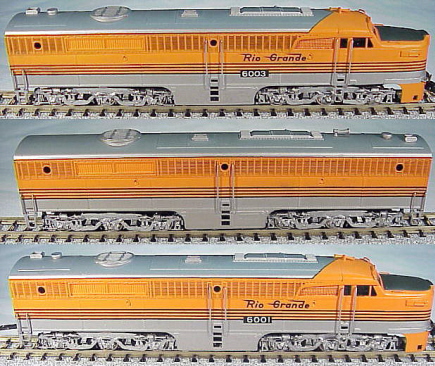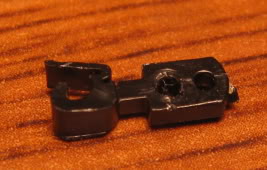| PA/PB-1/2 | PA-3/PB-3 |
 |  |
| PA/PB-1/2 | PA-3/PB-3 |
 |  |
Introduced: 1987
These sets all came out around the same time, so I'm going to go ahead and assume that they all sport the same basic chassis/mechanism. They were all sold in A/B/A sets (with all units powered). The "PA-1/2" designation means these models could stand in for either PA-1's or PA-2's (there being no external differences between the two prototypes).
The mechanism is very much typical of 1980s Samhongsa design, although the pickup scheme is a bit of a departure (more on that in a moment).

The chassis is a minimalistic rectangle of metal (with most of the model's weight coming from the brass shell). The motor is an open-sided / straight-wound five-poler. Each truck only collects current from a single rail (left rail current from the forward truck and right rail current from the rear truck). Four of the current collecting wheels use wheel-top wipers. As for the remaining two, I guess current flows from the axles directly into the metal truck assembly. There are no traction tires. A pair of wires route current from the trucks to the motor contacts. Multi-piece plastic driveshafts connect to the worm gear towers. Said towers are actually part of the truck assemblies and pivot right along with the trucks on curves. All axles are geared and all gearing is metal (including the compound gears inside of the truck towers - IE, none of those crappy "white plastic" gears used on earlier Samhongsa diesels). Wheels are low-profile, so no problems on Code-55 rails. There is no lighting or window glazing. A fixed / non-opertional knuckle coupler is mounted on the pilot of the "front end" A unit. My "tail end" A unit has a Micro-Trains coupler on its pilot, although I suspect that was added after the fact. Drawbars connect the A units to the B unit.
Paint and detailing are outstanding (as one would expect from Samhongsa brass). All the vents are of the "see through" ilk, all the handrails are separately applied detail parts, etc, etc. Unfortunately, performance is "just OK". On the plus side, slow speed creep is good, the top-end speed is reasonable, and pulling power is strong. The minimum radius for curves isn't bad - right around 11" (anything sharper than that and they're derailing). On the down side, these models are pretty darned noisy - emitting a beefy buzz-growl at all throttle levels (and the faster they go, the noisier they become). I guess if you're the kind of modeler who thinks big ol' Alcos should make some noise, you might actually enjoy the racket. As for me, I find it somewhat grating.
Noisiness aside, the main problem here is the "one rail per truck" pickup scheme. Yes, the trucks are big enough that out-and-out stalls aren't really a problem (even through turnouts with unpowered frogs). However, there are enough annoying little hiccups and pauses as they roll along to keep these models out of the "B" category (at least as far as performance is concerned). The odd thing is that virtually all the rest of Samhongsa's diesels do have two-rails-per-truck pickup, so I'm a bit mystified as to why they decided to take this small step backwards with these models.
To remove the shell, unscrew the four screws that hold it to the chassis. In the case of a B unit, the screws are on the ends. A units have two screws on one end and two screws underneath the center of the forward truck. Once the screws have been removed, the shell should lift right off (just be careful maneuvering the ladders past the chassis).
Tip - If you want to run an A/B (as opposed to an A/B/A) consist, Red Caboose makes a Unimate coupler that can be slid onto one of the B unit's drawbar posts. It's really quite slick -

Grade: C
Here's the PRR version of the PA/PB-1/2 -

And the SP version -
